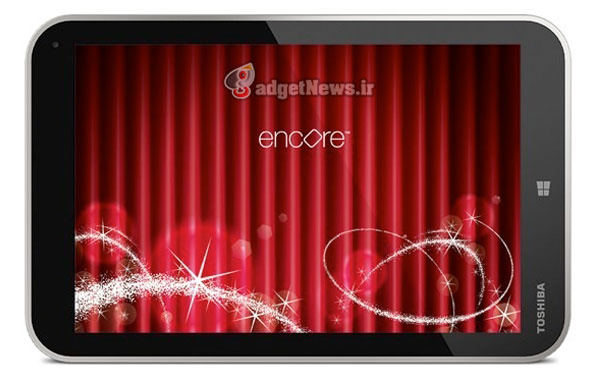
توشیبا می گوید حسابی از بابت ویندوز ۸.۱ هیجان زده است و معتقد به اینکه عرضه آن باعث به وجود آمدن فرصت های تازه خواهد شد، و در همین راستان علاوه بر معرفی Satellite Click، یک تبلت ۸ اینچی با نام Encore نیز معرفی کرده.
Encore دارای یک نمایشگر ۸ اینچی با رزولوشن ۱۲۸۰ در ۸۰۰ پیکسلی است و پردازنده ای از سری Atom اینتل دارد. توشیبا کمی بیشتر صبر کرده تا بتواند از چیپ ۴ هسته ای Bay Trail استفاده کند که عمر باتری بهتری را رقم می زند.
Encore با وزن ۴۷۰ گرم و ابعاد ۲۱۳ در ۱۳۶ در ۱۰.۶۸ میلیمتر، با توجه به اینکه یک تبلت است، در کل به نسبت رقبای اندرویدی و آیپدی خود، سنگین و حجیم به نظر می رسد.
از دیگر مشخصات آن می توان به این موارد اشاره کرد؛ ۲ گیگابایت رم، دوربین ۸ مگاپیکسلی در عقب و ۲ مگاپیکسلی در جلو که هر دو با کیفیت 1080p فیلمبرداری می کنند، دو میکروفون برای دریافت با کیفیت صدا، ۳۲ گیگابایت حافظه داخلی، شکاف میکرو اس دی تا ۶۴ گیگابایت، پورت میکرو یو اس بی، میکرو HDMI، جک کمبوی میکروفن-هدفون، و بلندگوهای استریو با تاییدیه Dolby Digital Plus.
{photo}92/06/17/encore{/photo}
با خرید این تبلت، کاربران از نسخه Home & Student آفیس ۲۰۱۳ مایکروسافت نیز بهره مند خواهند شد و نسخه های کامل ورد، پاورپوینت، و وان نوت را در اختیار خواهند گرفت -مزیتی که تبلت های اندرویدی و آیپد از آن بی بهره اند.
منبع : engadget
Toshiba Encore is the company's first 8-inch Windows tablet; coming November for $330 (hands-on)
Acer may have beaten everybody to market with the first 8-inch Windows tablet, but we knew it wouldn't be long before the other guys started catching up. Toshiba just entered the fray with the Encore, an 8-inch tablet that manages to be even cheaper than Acer's W3. Like the W3, it runs on an Atom processor, but because Toshiba waited longer it got to use one of Intel's new quad-core Bay Trail chips. What's interesting, too, is that Toshiba apparently worked closely with Microsoft on this, not just in optimizing the tablet for Windows 8.1, but in making sure the tablet's dual mics and 2MP front camera will be Skype-certified by the time it ships. The Encore arrives in early November – i.e., not long after Windows 8.1 ships. As for that price we alluded to, it'll cost $330 with a category-standard 1,280 x 800 display and 32GB of built-in storage (expandable via microSD). Not bad considering the W3 hit the market at $380, and is still going for about $350 in most places. That leaves just one teensy question: what's it like to use?
The Encore makes a good first impression. The screen, though standard in resolution, serves up pleasant colors, and wide viewing angles too, so far as we can tell. Hopefully our gallery of hands-on shots gives you a taste of the viewing experience you can expect while watching at a slightly off-kilter angle, or with the tablet lying face-up on a flat surface. (We can't, however, vouch for its performance in bright sunlight.) The tablet's also very easy and pleasant to hold, at just 479 grams (1.06 pounds). Even if you've got a small hand, like yours truly, you should have no problem holding onto it. What's more, a Toshiba rep staffing the company's IFA booth indicated that the tablet would ship with a more grippy material lining the sides.
In the meantime, though, as we said, it's hardly unwieldy. We were also pleased by the matte plastic material. Yes, it's a bit plain, in the way Samsung's Galaxy Tab 2 tablets from last year were plain. But plain can also mean inoffensive, which this indeed is: it might not sport a metal cover or a more pleasing soft-touch finish, but it at least does a good job repelling fingerprints. (And this is a good place to test that — imagine how many tech bloggers have handled this thing!)
Taking a tour around the device, you'll find all the standard accoutrements: an open microSD slot, a volume rocker, et cetera. What's nice is that Toshiba positioned all of these on the sides and toward the top, so that when you're using this in portrait mode (and you probably will be, since it's an 8-inch tablet), your fingers won't brush up against anything.
As for performance, that's the sort of thing we'll need to evaluate when we eventually do a full review. We did notice a slight delay when we flipped the screen from portrait to landscape mode — the sort of hiccup we've seen on many other tablets as well. Again, though, we're willing to file that first impression away until we can spend some time with a final retail model.
 گجت نیوز آخرین اخبار تکنولوژی، علم و خودرو
گجت نیوز آخرین اخبار تکنولوژی، علم و خودرو 





